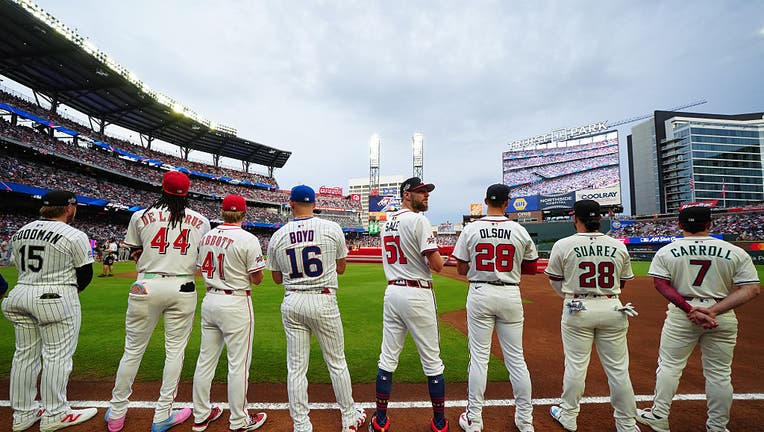MLB tests robot umpires in 2025 All-Star Game with challenge system

Members of the National League Team stand along the baseline prior to the 95th MLB All-Star Game presented by Mastercard at Truist Park on Tuesday, July 15, 2025 in Atlanta, Georgia. (Photo by Daniel Shirey/MLB Photos via Getty Images)
Tarik Skubal might think everything he throws is a strike—but this time, it’s up to a robot to decide.
For the first time, Major League Baseball is testing its automated ball-strike (ABS) system on the biggest stage of the summer: the All-Star Game. The technology, which has been in use in parts of the minor leagues since 2019, allows each team two challenges per game—similar to tennis—with the right to retain them if successful.
The system has sparked mixed reactions from pitchers and managers alike. Some say it brings a new level of accuracy and consistency. Others still trust a good old-fashioned umpire’s eye.
How does MLB’s robot umpire system work?
The backstory:
The automated ball-strike system uses tracking data to determine whether a pitch crosses a defined strike zone. For All-Star Game use, MLB has defined the top of the zone as 53.5% of a batter’s height and the bottom as 27%, measured at the midpoint of home plate.
That’s a key difference from the traditional "cube"-style rulebook zone that umpires have long interpreted by eye. The result? A strike zone that adjusts per batter, accounting for the difference between players like 6’7" Aaron Judge and 5’6" Jose Altuve.
What we know:
During spring training, MLB tested the ABS challenge system and teams won 52.2% of their appeals. Batters were successful exactly 50% of the time, while catchers had a 56% win rate and pitchers trailed at 41%.
While pitchers like Skubal and Paul Skenes joke that they assume everything is a strike, the system shows a more impartial reality—often catching calls off the edge that human umps might miss.
What we don't know:
It’s still unclear when or if MLB plans to fully implement the system at the major league level. Commissioner Rob Manfred has indicated the sport’s 11-person competition committee, which includes six representatives from team management, will eventually take up the issue.
What they're saying:
"I have this thing where I think everything is a strike until the umpire calls it a ball," Skubal said ahead of his start for the American League.
"Pitchers think everything is a strike. Then you go back and look at it, and it’s two, three balls off," Paul Skenes said Monday. "We should not be the ones that are challenging it."
"I did a few rehabs starts with it. I’m OK with it. I think it works," Dodgers ace Clayton Kershaw said. "Aaron Judge and Jose Altuve should have different sized boxes. They’ve obviously thought about that. As long as that gets figured out, I think it’ll be fine."
Hall of Fame manager and former MLB executive Joe Torre added: "You couldn’t ignore it with all the technology out there. You couldn’t sit and make an excuse for, ‘Look at what really happened’ the next day."
Torre even admitted his Yankees once benefitted from a missed strike call in the 1998 World Series. Asked if he was glad robot umps weren’t around then, he grinned and said: "Possibly." Then added, "Well, not to mention the home run that Jeter hit."
What's next:
Whether the tech makes its way into regular-season play remains to be seen, but MLB’s expansion of ABS testing to the All-Star Game shows growing interest.
The system will likely come under further review by the competition committee in the coming months, especially as players and fans get more familiar with how it affects game flow and fairness.
The Source: This article is based on reporting from the Associated Press, which covered the debut of MLB’s automated ball-strike system at the 2025 All-Star Game. Player quotes and background on the strike zone system were drawn directly from AP interviews and league-provided data from spring training testing.

